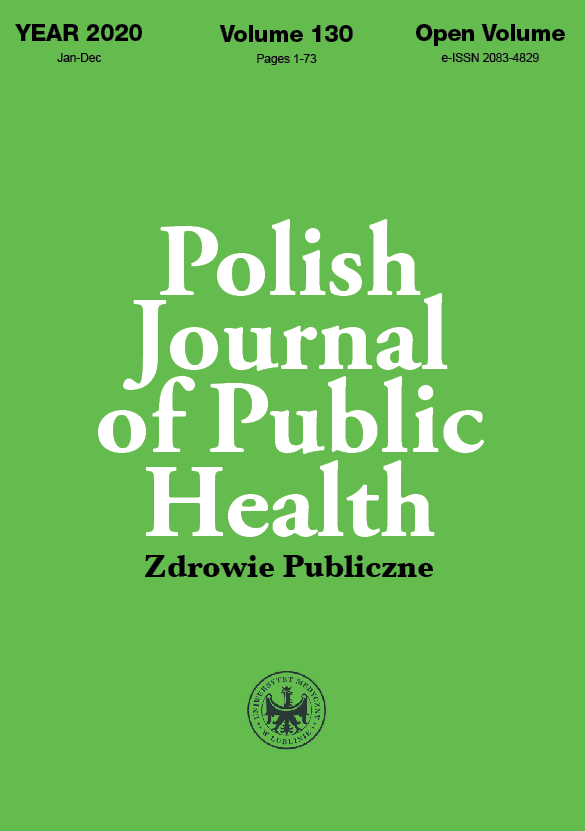Burnout syndrome among nurses of hospitals in Wrocław, including seniority assessed with Maslach Burnout Inventory (MBI) and Work Satisfaction Scale (WSS)
DOI:
https://doi.org/10.2478/pjph-2020-0006Słowa kluczowe:
burnout, nurse, burnout syndrome.Abstrakt
Introduction. Burnout syndrome among nurses is very common. It develops very dynamically, it is mainly related to the reaction to long-term emotional stress, as well as to the professional work they perform.
Aim. The aim of the study is to assess the degree of occupational burnout in the professional group of nurses.
Material and methods. The research was conducted among 123 professionally active nurses employed in an outpatient clinic and a hospital in Wrocław. The work uses standardized research tools: Maslach Burnout Inventory (MBI) and Work Satisfaction Scale (WSS).
Results. Nurses in old age, with longer work experience, are at a higher risk of burnout.
Conclusion. Burnout as measured by the Maslach Burnout Inventory (MBI) and Work Satisfaction Scale (WSS) in nurses is associated with higher age and seniority. In addition, a negative correlation was noted between Maslach Burnout Inventory (MBI) and Work Satisfaction Scale (WSS)
Bibliografia
1. Pines AM. Wypalenie w perspektywie egzystencjalnej. In: H. Sęk (ed). Wypalenie zawodowe: przyczyny, mechanizmy, zapobieganie. Warszawa: Wydawnictwo Naukowe PWN; 2000. p.32-57.
2. Siemiński M, Nitka-Siemińska A, Nyka W. Zespół wypalenia. Forum Med. Rodz. 2007:1(1);45-9.
3. Jarzynkowski P, Książek J, Piotrkowska R, Dobosz M. Zespół wypalenia zawodowego wśród pracowników zawodów medycznych. Med Rodz. 2017:20(2);105-10.
4. Maslach C, Leiter M. Early predictors of job burnout and engagement. J Appl Psychol. 2008:3;498-512.
5. Chirkowska-Smolak T. Organizacyjne czynniki wypalenia zawodowego, ruch prawniczy, ekonomiczny i socjologiczny. Poznań: Wydział Prawa i Administracji UAM; 2009.p. 257-61.
6. Kowalczuk K, Zdańska A, Krajewska-Kułak E, et al. Stres w pracy pielęgniarek jako czynnik ryzyka wypalenia zawodowego. Probl Pielęg. 2011:19(3):307-14.
7. Ramuszewicz M, Krajewska-Kułak E, Rolka H, Łukaszuk C. Próba oceny wiedzy na temat zespołu wypalenia zawodowego wśród pielęgniarek bloku operacyjnego. Pielęg XXI. 2004:3(8):25-30.
8. Ptaszek G, Stołecka B, Graf L, Śleziona M. Wypalenie zawodowe pielęgniarek. Pielęg Specjalist. 2014:1(4);180-4.
9. Uchmanowicz I, Manulik S, Lomper K. Life satisfaction, job satisfaction, life orientation and occupational burnout among nurses and midwives in medical institutions in Poland: a cross-sectional study. BMJ Open. 2019;9(1):1-9.
10. Spooner-Lane RS, Patton WA. Determinants of burnout among public hospital nurses. The AJAN. 2007;25(1):8-8.
11. Tay WY, Tan SY, Earnest A, Ming Ng MJ. Prevalence of burnout among nurses in a Community Hospital in Singapore: a Cross-sectional study. PoSH. 2014:2(23):93-9.
12. Anczewska M, Świtaj P, Roszczyńska J. Wypalenie zawodowe. Adv Psychiatry Neurol. 2005;14(2):67-77.
13. Tucholska S. Wypalenie zawodowe w ujęciu strukturalnym i dynamicznym. Lublin: Instytut Psychologii KUL. 2009. p. 10-2
Pobrania
Opublikowane
Numer
Dział
Licencja
Prawa autorskie (c) 2021 Polish Journal of Public Health

Praca jest udostępniana na licencji Creative Commons Attribution-NonCommercial-NoDerivatives 3.0 Unported License.


